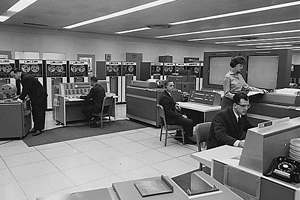
Director's Update: Enabling the Evolution of Oncology
 Dr. John E. Niederhuber
Dr. John E. Niederhuber
Radio transcripts from the 1960s reveal how a relatively new technology, the computer, had begun to alter research and the practice of medicine. "We have made extensive use [of computers] so far, but I think much more lies in the future," said then NCI Director Dr. Carl G. Baker during one such interview. "Massive amounts of information accumulate very rapidly."
Dr. Baker's comments hinted at what we see today, a time when journal publications and research conferences regularly reveal new ways to identify the nuances of a person's biological profile that may help tailor interventions for cancer to maximize clinical benefit and mitigate potential harm. We are entering the age of personalized medicine.
However, a robust bioinformatics infrastructure is critical for achieving truly individualized care. That means developing the tools necessary to mine and analyze the vast amounts of clinical, molecular, and epidemiologic data.
I'm proud to say that we are moving in that direction. For example, using an approach whereby glioblastoma (GBM) tumor samples were painstakingly characterized using different genomic strategies, researchers with The Cancer Genome Atlas (TCGA) identified new mutations, a core set of often simultaneously deregulated molecular pathways, and a potential mechanism of resistance to the most commonly used chemotherapy agent for GBM. In effect, three actionable findings from a sophisticated, collaborative analysis that could eventually lead to more tailored treatments for patients with this disease.
TCGA, like many other advances reported on regularly in the NCI Cancer Bulletin, would not exist without the underlying technology that enables these discoveries. That is why we are highlighting in this special issue of the NCI Cancer Bulletin the role of bioinformatics in cancer research and issues that surround its development and adoption.
 Computers from the 1960s
Computers from the 1960s
At NCI, we are investing heavily in developing a nationwide bioinformatics structure, most notably through our Center for Biomedical Informatics and Information Technology and our landmark initiative, the cancer Biomedical Informatics Grid, or caBIG®. Our goal is to create a seamless system for the storage and access of data—a system that facilitates data exchange and collaboration, so that a cancer center in California can easily interface with a community oncology center in Tennessee. In this way, the same data a community oncologist uses to work with a patient in making a treatment decision can also be used by researchers analyzing whether a new screening test improves survival.
A key element in this bioinformatics equation will eventually be electronic health records (EHRs). President Obama and his administration have directed a significant portion of ARRA funding for health information technology, including EHRs, and NCI staff in various divisions are working on important EHR-related projects.
The topic of bioinformatics is remarkably broad. I encourage you to follow up with our staff and the programs listed in the following articles to find out more about their tools and projects and how you can get involved.
Dr. John E. Niederhuber
Director, National Cancer Institute